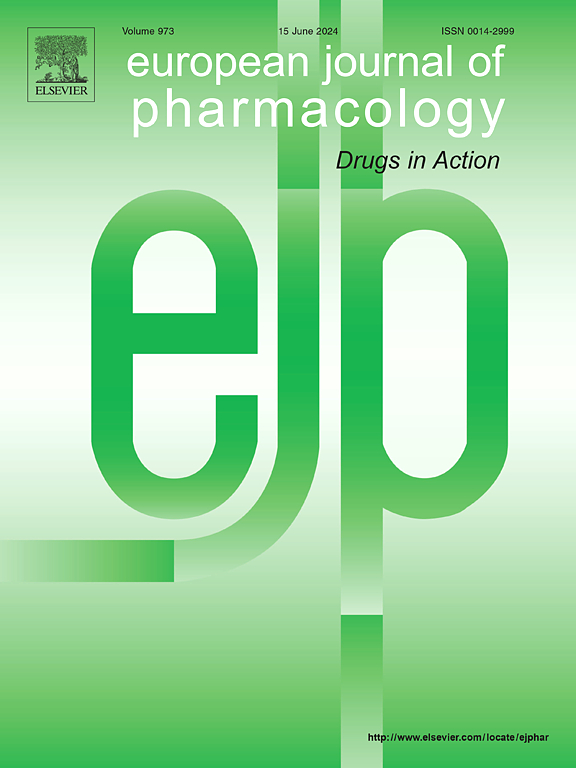Leukemia inhibitory factor receptor inhibition by EC359 reduces atherosclerotic stenosis grade in Ldlr−/− mice
IF 4.2
3区 医学
Q1 PHARMACOLOGY & PHARMACY
引用次数: 0
Abstract
Cytokines are involved in all stages of atherosclerosis, generally contributing to disease progression. Previously, members of the Interleukin (IL)-6 cytokine family, such as IL-6, oncostatin M, and cardiotrophin-1, have been extensively studied in atherosclerosis. However, the role of leukemia inhibitory factor (LIF), member of the IL-6 family, and its receptor (LIFR), remains to be further elucidated. Therefore, the aim of this study is to provide insight in LIF receptor signalling in atherosclerosis development.
Single-cell RNA sequencing analysis of human carotid artery plaques revealed that mast cells highly express LIF, whereas LIFR was specifically expressed on activated endothelial cells. A similar expression pattern of Lifr was observed in mouse atherosclerotic plaques. Next, female Western-type diet fed Ldlr−/− mice were treated with LIF receptor inhibitor EC359 (5 mg/kg s.c., n = 15) or control solvent (n = 15) three times per week for eight weeks. Stenosis grade was reduced in the aortic root of EC359 treated mice compared to control mice, but treatment did not affect plaque composition. Serum cholesterol levels were significantly reduced in EC359 treated mice, likely attributed to a reduction in VLDL cholesterol levels. Furthermore, LIF receptor inhibition reduced Pecam1 and Vcam1 expression in the aorta. Consequently, immune cell infiltration was reduced in aortic plaques of EC359 treated mice compared to control mice.
Conclusively, we demonstrated that LIF receptor is a potential therapeutic target in atherosclerosis by reducing plaque size, attributed to lower serum cholesterol levels, reduced endothelial activation and less immune cell infiltration in the plaque.
EC359 对白血病抑制因子受体的抑制可降低 Ldlr-/- 小鼠动脉粥样硬化性狭窄的等级。
细胞因子参与了动脉粥样硬化的各个阶段,通常会导致疾病进展。此前,白细胞介素-6、oncostatin M 和心脏营养素-1 等 IL-6 细胞因子家族成员在动脉粥样硬化中的作用已被广泛研究。然而,IL-6 家族中的白血病抑制因子(LIF)及其受体(LIFR)在动脉粥样硬化中的作用仍有待进一步阐明。因此,本研究旨在深入了解 LIF 受体信号在动脉粥样硬化发展过程中的作用。对人类颈动脉斑块进行的单细胞 RNA 测序分析表明,肥大细胞高度表达 LIF,而 LIFR 则在活化的内皮细胞上特异性表达。在小鼠动脉粥样硬化斑块中也观察到了类似的 Lifr 表达模式。接下来,用 LIF 受体抑制剂 EC359(5 mg/kg s.c.,n=15)或对照溶剂(n=15)治疗雌性西式饮食喂养的 Ldlr-/- 小鼠,每周三次,连续八周。与对照组小鼠相比,接受EC359治疗的小鼠主动脉根部狭窄等级降低,但治疗并不影响斑块的组成。经 EC359 治疗的小鼠血清胆固醇水平明显降低,这可能是由于 VLDL 胆固醇水平降低所致。此外,LIF 受体抑制降低了主动脉中 Pecam1 和 Vcam1 的表达。因此,与对照组小鼠相比,EC359 治疗小鼠主动脉斑块中的免疫细胞浸润减少了。最后,我们证明了 LIF 受体是动脉粥样硬化的潜在治疗靶点,它能缩小斑块,降低血清胆固醇水平,减少内皮活化和免疫细胞在斑块中的浸润。
本文章由计算机程序翻译,如有差异,请以英文原文为准。
求助全文
约1分钟内获得全文
求助全文
来源期刊
CiteScore
9.00
自引率
0.00%
发文量
572
审稿时长
34 days
期刊介绍:
The European Journal of Pharmacology publishes research papers covering all aspects of experimental pharmacology with focus on the mechanism of action of structurally identified compounds affecting biological systems.
The scope includes:
Behavioural pharmacology
Neuropharmacology and analgesia
Cardiovascular pharmacology
Pulmonary, gastrointestinal and urogenital pharmacology
Endocrine pharmacology
Immunopharmacology and inflammation
Molecular and cellular pharmacology
Regenerative pharmacology
Biologicals and biotherapeutics
Translational pharmacology
Nutriceutical pharmacology.

 求助内容:
求助内容: 应助结果提醒方式:
应助结果提醒方式:


